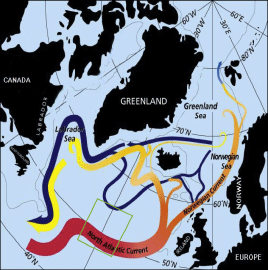Why is the Charlie-Gibbs MPA special?

The varied topography of this zone together with the subpolar frontal area in the surface waters creates many different habitats and ocean conditions. Along the ridge, these include hard bottom habitats provided by seamounts and other elevations of various extent and steepness, soft sediment areas in the rift valleys and trenches including an abyssal plain at the foot of the ridge. The Charlie-Gibbs Fracture Zone is the deepest of several fracture zones, which allows for an east-west exchange of deep-sea fauna.
Coinciding with the location of the Charlie-Gibbs Fracture Zone, in an overlaying front warm, nutrient-poor water from the south meets cold nutrient-rich water from the north. In this mixing zone the overall biological productivity, biomass and species pool is enhanced and supplies all the food web down to the deep sea with biomass. So far, 40 cold-water coral taxa, 53 species of cephalopods, 80 species of demersal fish – including 44 species of deepwater sharks, 22 species of seabirds, and 13 cetacean species have been identified. As the front moves several degrees in latitude north and south seasonally, it fertilizes a large, otherwise low productive region along the Mid-Atlantic Ridge.
